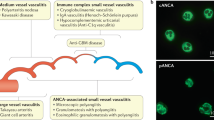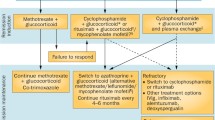Abstract
The pathogenesis of systemic vasculitis is complex and is likely to involve many mechanisms. There is a growing body of evidence that T cells may contribute to the pathogenesis of anti-neutrophil cytoplasmic antibody (ANCA)-associated vasculitides. Predominantly, T cells and monocytes are found in inflammatory infiltrates in patients with Wegener's granulomatosis (WG). The production of ANCA appears to be T-cell-dependent. T lymphocytes from the peripheral blood of patients with ANCA-associated vasculitis have been shown to proliferate in response to proteinase 3 (PR3). These and other findings outlined in this review indicate T-cell involvement, although further studies are still needed to elucidate the exact contribution of T cells to the pathogenesis of systemic vasculitis.
Similar content being viewed by others
Introduction
Systemic vasculitis is characterised by the inflammation and necrosis of blood-vessel walls. This leads to circulatory compromise and ischaemia in the organs supplied by the damaged vessels. ANCAs with specificity for PR3 are found in many patients with WG. The evidence that T cells are involved in the pathogenesis of systemic vasculitis is outlined in this review.
In vivo evidence for T-cell involvement in systemic vasculitis
As long ago as 1983, T cells and monocytes were found to be the predominant cell types in inflammatory vascular and perivascular lymphoid infiltrates in WG, suggesting these cells play an important role in this disease [1]. The predominant IgG subclasses of ANCA in patients with WG are IgG1 and IgG4 [2]. Isotype switching from IgG1 to IgG4 is dependent on repeated antigenic stimulation and also on T-cell cytokines such as IL-4, which suggests that the production of the antibodies is T-cell-dependent. Furthermore, in patients with WG, the concentrations of soluble IL-2 receptor, which is a marker of T-cell activation, correlate well with disease activity [3].
In vitro analyses of peripheral blood T cells
Studies of the potential for peripheral blood T cells from patients with ANCA-associated systemic vasculitis to respond to PR3 have given conflicting results. Early studies suggested that T-cell proliferative responses to neutrophil antigens were present in patients but not in controls [4], although the patient numbers used were very small. Some more recent studies have shown little or no difference in T-cell reactivity to PR3 between patients and controls [5,6]. The lack of difference may have been due to the crude nature of the PR3 antigen preparation used [6] or to the use of detergents during the isolation and purification of PR3 [5,7]. Responses by peripheral blood T cells to PR3 purified without detergent were seen in patients tested during the acute stage of the disease, and to a lesser extent in normal and disease controls [8]. The largest study looking at T-lymphocyte responses to ANCA antigens in patients with ANCA-associated systemic vasculitis was in 45 patients at all stages of disease - active and remitting, treated and untreated - and in 19 normal and disease controls [9*]. Proliferative responses to PR3 purified without detergent were seen using T cells from vasculitis patients, whether in remission or at any stage of disease activity, and to a lesser degree in controls [9*]. Recent studies have confirmed T-lymphocyte responses to PR3 in patients with ANCA-associated vasculitis (AR Clayton, unpublished data). T cells from healthy individuals may also proliferate to PR3, reflecting responses from T cells that have previously encountered this self-antigen and that are under regulatory control under normal conditions in vivo. The PR3 epitopes that are presented to T cells, whether in patients or normal individuals, have not been defined. One study found significant responses from a single patient to three PR3 peptides: amino acid (aa) 1-26, aa 161-186, and aa 221-246 [9*].
T-cell receptor (TCR) V gene usage
Patients with vasculitides often have a disturbed peripheral blood T-cell repertoire, with a high frequency of T-cell expansions. This may be due to superantigens (usually microbial proteins), which cause dramatic expansions of T lymphocytes bearing a particular variable-region (V)β gene product [10]. Conventional antigens, on the other hand, usually stimulate T cells bearing several V gene products. One study has looked at the number of cells expressing certain Vα and Vβ gene segments in the CD4+ and CD8+ subsets of 11 patients with WG or polyarteritis and in 19 controls [11]. In the patient group, abnormal expansions of T cells using particular TCR Vα or Vβ gene products were found (especially in the CD4+ subset) compared with T-cell expansions in healthy individuals. Another study found a significant increase in the mean percentage expression of the Vβ 2.1 gene in the peripheral blood of vasculitis patients compared with controls [12]. There were also increases in the expression of Vβ 3, 13, and 14 in vasculitis patients compared with controls. More recently, workers decided to characterise more closely the TCR of T-cell populations from human leucocyte antigen (HLA)-typed patients with WG or polyarteritis [13**]. These workers found a common TCR BV8 β chain sequence in the CD4+ subsets of four unrelated patients with vasculitis who were positive for the HLA-DRb1*0401 allele, corresponding to active disease and/or BV8+ CD4+ T-cell expansions. Such T cells were not found in age- and HLA-matched controls who had rheumatoid arthritis. The researchers suggested that patients with systemic vasculitis have been exposed to a common antigen, which has elicited a cellular immune response.
Cytokines and costimulation
Wegener's granulomatosis, as the name suggests, involves granulomatous inflammation. The profile of cytokine secretion by T cells derived from tissue with granulomatous inflammation (nasal mucosal biopsy specimens) or from an area close to the site of granulomatous inflammation (bronchiolar lavage fluid) have been analysed and compared with results from peripheral blood T cells [14*]. A T-helper (Th)1 pattern of cytokines predominates in T cells derived from the tissue of granulomatous inflammation and bronchiolar lavage fluid, as well as in T cells from peripheral blood. Other studies of peripheral blood T cells from patients with WG have previously shown that these cells exhibit increased secretion of interferon (IFN)γ but not of IL-4, IL-5, or IL-10, suggesting a Th1 response in the periphery [15**].
Activation of T cells involving cytokine production and proliferation requires at least one costimulatory signal. The expression of CD28 on T cells has been reported to be significantly lower in patients with WG than in healthy controls, while expression of B7-1 and B7-2 on T cells activated in vitro is increased in these patients [16*]. CD28 costimulation promotes the production of Th2 cytokines [17,18]. In the absence of this costimulation, cells are not primed to produce Th2 cytokines and so they 'default' to the Th1 subset, independently of the presence of exogenous cytokines [19]. If, as discussed, a Th1 cytokine profile predominates in the granuloma and peripheral blood of patients with WG [14*], this lack of CD28 costimulation in such patients may augment the development of the Th1 pattern. Th1 cells are more dependent on B7 costimulation for their activation than Th2 cells are [20], and therefore the increased expression of B7 on T cells from patients with WG may also promote the Th1 immunoreaction leading to granuloma formation and necrotising inflammation [16*].
Conclusion
T cells appear to be involved in the pathogenesis of systemic vasculitis, but their specific role is still uncertain. The immunopathological process is T-cell-driven and ANCA production appears to be T-cell-dependent. Peripheral blood T-cell responses to PR3-ANCA are seen in patients and to a lesser extent in controls. Selection of particular TCRs in patients with systemic vasculitis may suggest the existence of a specific vasculitis-associated T-cell antigen. Understanding the mechanisms resulting in loss of tolerance in patients with systemic vasculitis may be of importance for prognosis and the development of new immunotherapies.
References
Gephardt GN, Ahmad M, Tubbs RR: Pulmonary vasculitis (Wegener's granulomatosis): immunohistochemical study of T and B cell markers. Am J Med. 1983, 74: 700-704.
Brouwer E, Cohen Tervaert JW, Horst G: Predominance of IgG1 and IgG4 subclasses of anti-neutrophil cytoplasmic autoantibodies (ANCA) in patients with Wegener's granulomatosis and clinically related disorders. Clin Exp Immunol. 1991, 83: 379-386.
Schmitt WH, Heesen C, Csernok E, Rautmann A, Gross WL: Elevated serum levels of soluble interleukin-2 receptor in patients with Wegener's granulomatosis: association with disease activity. Arthritis Rheum . 1992, 35: 1088-1096.
Van der Woude FJ, Van Es LA, Daha MR: The role of the c-ANCA antigen in the pathogenesis of Wegener's granulomatosis: a hypothesis based on both humoral and cellular mechanisms. Neth J Med. 1990, 36: 169-171.
Brouwer E, Stegeman CA, Huitema MG, Limburg PC, Kallenberg CGM: T cell reactivity to proteinase 3 in patients with Wegener's granulomatosis (WG). Clin Exp Immunol. 1994, 98: 448-453.
Mathieson PW, Oliviera DBG: The role of cellular immunity in systemic vasculitis. Clin Exp Immunol. 1995, 100: 183-185.
Ballieux BEPB, Van der Burg SH, Hagen EC, Van der Woude FJ, Melief CJM, Daha MR: Cell-mediated autoimmunity in patients with Wegener's granulomatosis (WG). Clin Exp Immunol. 1995, 100: 186-193.
Griffith ME, Coulthart A, Pusey CD: T cell responses to myeloperoxidase (MPO) and proteinase 3 (PR3) in patients with systemic vasculitis. Clin Exp Immunol. 1996, 103: 253-258. 10.1046/j.1365-2249.1996.d01-629.x.
King WJ, Brooks CJ, Holder R, Hughes P, Adu D, Savage COS: T lymphocyte responses to anti-neutrophil cytoplasmic autoantibody (ANCA) antigens are present in patients with ANCA-associated systemic vasculitis and persist during disease remission. Clin Exp Immunol . 1998, 112: 539-546. 10.1046/j.1365-2249.1998.00615.x.
Scherer MT, Ignatowicz L, Winslow GM: Superantigens: bacterial and viral proteins that manipulate the immune system. Ann Rev Cell Biol. 1993, 9: 101-128.
Giscombe R, Grunewald J, Nityanand S, Lefvert AK: T cell receptor (TCR) V gene usage in patients with systemic necrotising vasculitis. Clin Exp Immunol. 1995, 101: 213-219.
Simpson IJ, Skinner MA, Geursen A: Peripheral blood T lymphocytes in systemic vasculitis: increased T cell receptor Vβ2 gene usage in microscopic polyarteritis. Clin Exp Immunol. 1995, 101: 220-226.
Grunewald J, Halapi E, Wahlström J: T-cell expansions with conserved T-cell receptor β chain motifs in the peripheral blood of HLA-DRB1*0401 positive patients with necrotising vasculitis. Blood. 1998, 92: 3737-3744.
Csernok E, Trabandt A, Müller A: Cytokine profiles in Wegener's granulomatosis: predominance of type 1 (Th1) in the granulomatous inflammation. Arthritis Rheum. 1999, 42: 742-750. 10.1002/1529-0131(199904)42:4<742::AID-ANR18>3.3.CO;2-9.
Lúdvíksson BR, Sneller MC, Chua KS: Active Wegener's granulomatosis is associated with HLA-DR + CD4 + T cells exhibiting an unbalanced Th1-type T cell cytokine pattern: reversal with IL-10. J Immunol. 1998, 160: 3602-3609.
Moosig F, Csernok G, Wang G, Gross WL: Costimulatory molecules in Wegener's granulomatosis (WG): lack of expression of CD28 and preferential up-regulation of its ligands B7-1 (CD80) and B7-2 (CD86) on T cells. Clin Exp Immunol. 1998, 114: 113-118. 10.1046/j.1365-2249.1998.00695.x.
Rulifson IC, Sperling AI, Fields PE, Fitch FW, Bluestone JA: CD28 costimulation promotes the production of Th2 cytokines. J Immunol. 1997, 158: 658-665.
King CL, Stupi RJ, Craighead N, June CH, Thyphonitis G: CD28 activation promotes Th2 subset differentiation by human CD4+ cells. Eur J Immunol. 1995, 25: 587-595.
Webb LMC, Fieldmann M: Critical role of CD28/B7 costimulation in the development of human Th2 cytokine-producing cells. Blood. 1995, 86: 3479-3486.
Gause WC, Halvorson MJ, Lu P: The function of costimulatory molecules and the development of IL-4-producing T cells. Immunol Today. 1997, 18: 115-120. 10.1016/S0167-5699(97)01005-0.
Author information
Authors and Affiliations
Rights and permissions
About this article
Cite this article
Clayton, A.R., Savage, C.O. What you should know about PR3-ANCA: Evidence for the role of T cells in the pathogenesis of systemic vasculitis. Arthritis Res Ther 2, 260 (2000). https://doi.org/10.1186/ar98
Received:
Accepted:
Published:
DOI: https://doi.org/10.1186/ar98




